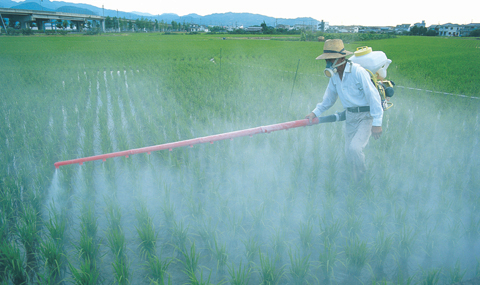|
|||||||||||||||
|

CLICK ON weeks 0 - 40 and follow along every 2 weeks of fetal development
|
||||||||||||||||||||||||||||
|
OB-GYN group urges prevention of chemical exposure FIGO represents obstetricians from 125 countries and territories. It published it's opinion in the International Journal of Gynecology and Obstetrics on Oct. 1, 2015, just prior to its Oct. 4 to 9, 2015, world congress in Vancouver, BC, where more than 7,000 clinicians and scientists will explore global trends in women's health issues. The opinion was written by obstetrician-gynecologists and scientists from the United States, United Kingdom and Canadian reproductive health societies, the World Health Organization and the University of California, San Francisco (UCSF).
According to the FIGO opinion, miscarriage, still birth, impaired fetal growth, congenital malformations, impaired or reduced neurodevelopment and cognitive function, as well as an increase in cancer, attention problems, ADHD behaviors and hyperactivity are among the list of poor health outcomes linked to chemicals such as pesticides, air pollutants, plastics, solvents and more, "What FIGO is saying is that physicians need to do more than simply advise patients about the health risks of chemical exposure," said Jeanne A. Conry, MD, PhD, a co-author of the FIGO opinion and past president of the American College of Obstetricians and Gynecologists, which issued an opinion on chemicals and reproductive health in 2013. "We need to advocate for policies that will protect our patients and communities from the dangers of involuntary exposure to toxic chemicals." Chemical manufacturing is expected to grow fastest in developing countries in the next five years, according to FIGO. In the U.S. alone, more than 30,000 pounds of chemicals per person are manufactured or imported, and yet the vast majority of these chemicals have not been tested. Chemicals travel the globe via international trade agreements, such as the Transatlantic Trade and Investment Partnership being negotiated between the European Union and the United States. Environmental and health groups have criticized the proposed agreement for weakening controls and regulations designed to protect communities from toxic chemicals. "Exposure to chemicals in the air, food and water supplies disproportionately affect poor people," said Linda Giudice, MD, PhD, MSc, a FIGO opinion co-author, past president of the American Society for Reproductive Medicine (ASRM) and chair of the UCSF department of obstetrics, gynecology and reproductive sciences. "In developing countries, lower respiratory infections are more than twice as likely to be caused by chemical exposures than in developed countries."
"Given accumulating evidence of adverse health impacts related to toxic chemicals, including the potential for inter-generational harm, FIGO has wisely proposed a series of recommendations that health professionals can adopt to reduce the burden of unsafe chemicals on patients and communities," explained Sabaratnam Arulkumaran, MBBS, FIGO President, and past president of the British Medical Association. FIGO proposes physicians, midwives, and other reproductive health professionals advocate for policies preventing exposure to toxic environmental chemicals, while working to ensure a healthy food system for all; make environmental health part of health care and champion environmental justice. Abstract The FIGO opinion was authored by representatives from the American College of Obstetricians and Gynecologists, American Society for Reproductive Medicine, International Federation of Gynecology and Obstetrics, Royal College of Obstetricians and Gynaecologists, Society of Obstetricians and Gynaecologists of Canada, UCSF's Program on Reproductive Health and the Environment, and the World Health Organization. These and numerous other reproductive health organizations have either endorsed or formally supported FIGO's opinion. The FIGO opinion has also been applauded by health and advocacy groups, including the Health and Environment Alliance (HEAL), Women in Europe for a Common Future (WECF), Healthcare Without Harm, and Physicians for Social Responsibility. The International Federation of Gynecology and Obstetrics (FIGO) is a non-profit organization that brings together obstetrical and gynecological associations from 125 countries/territories worldwide. It is dedicated to the improvement of women's health and rights and to the reduction of disparities in healthcare available to women and newborns, as well as to advancing the science and practice of obstetrics and gynecology. Based in London, the organization hosts a triennial World Congress that draws more than 7,000 women's health scientists, clinicians, and other allied health professionals to present the latest science and best clinical practice in obstetrics and gynecology. This year's XXI World Congress will be held in Vancouver. UC San Francisco (UCSF) is a leading university dedicated to promoting health worldwide through advanced biomedical research, graduate-level education in the life sciences and health professions, and excellence in patient care. It includes top-ranked graduate schools of dentistry, medicine, nursing and pharmacy, a graduate division with nationally renowned programs in basic, biomedical, translational and population sciences, as well as a preeminent biomedical research enterprise and two top-ranked hospitals, UCSF Medical Center and UCSF Benioff Children's Hospital San Francisco. Please visit http://www.ucsf.edu. |
Oct 6, 2015 Fetal Timeline Maternal Timeline News News Archive Substances that cause cancer should be replaced with safer alternatives. If it isn’t possible
|
||||||||||||||||||||||||||||


